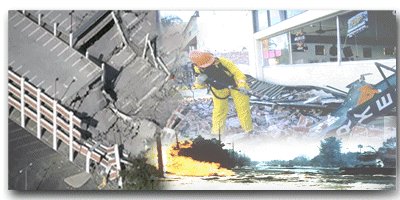| I. |
Not felt except by a very few under
especially favorable conditions. |
| II. |
Felt only by a few persons at rest,
especially on upper floors of buildings. Delicately suspended objects may
swing. |
| III. |
Felt quite noticeably by persons indoors,
especially on upper floors of buildings. Many people do not recognize it as
an earthquake. Standing motor cars may rock slightly. Vibration similar to
the passing of a truck. Duration estimated. |
| IV. |
Felt indoors by many, outdoors by few during
the day. At night, some awakened. Dishes, windows, doors disturbed; walls
make cracking sound. Sensation like heavy truck striking building. Standing
motor cars rocked noticeably. |
| V. |
Felt by nearly everyone; many awakened. some
dishes, windows broken. Unstable objects overturned. |
| VI. |
Felt by all, many frightened. Some heavy
furniture moved; a few instances of fallen plaster. Damage slight.
|
| VII. |
Damage negligible in buildings of good design
and construction; slight to moderate in well-built ordinary structures;
considerable damage in poorly built or badly designed structures; some
chimneys broken. |
| VIII. |
Damage slight in specially designed
structures; considerable damage in ordinary substantial buildings with
partial collapse. Damage great in poorly built structures. Fall of chimneys,
factory stacks, columns, monuments, walls. Heavy furniture overturned.
|
| IX. |
Damage considerable in specially designed
structures; well-designed frame structures thrown out of plumb. Damage great
in substantial buildings, with partial collapse. Buildings shifted off
foundations. |
| X. |
Some well-built wooden structures destroyed;
most masonry and frame structures destroyed with foundations. Rail bent. |
| XI. |
Few, if any (masonry)
structures remain standing. Bridges destroyed. Rails bent greatly.
|
| XII. |
Damage total. Lines of
sight and level are distorted. Objects thrown into the air. |
March 5, 1958
Wilmington, NC |
Intensity:
V (five)
Magnitude: 0
Damage: Shocks transpired along the coast rolling people out of bed
and shaking houses. |
1987
North Carolina/Tennessee border |
Magnitude
4.2
Largest to occur in the Southeast that year. |
June 14, 1997
Henderson County, NC |
Magnitude
2.5, Small earthquake
Damage: None reported |
June 5, 1998
Mooresville, NC |
Magnitude
3.2, Small earthquake
Damage: None reported |

![[nc fault zone map]](qu1.gif)